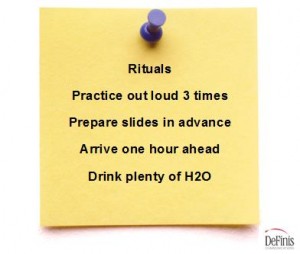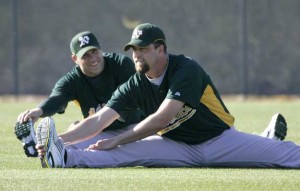What are the lessons for the public speaker?
Ah…finally…Opening Day. I’m a huge baseball fan, so the beginning of baseball season is always an exciting time. Just the thought of heading to a mid-week game, grabbing a program and a hot dog, and rooting for the home team (The Oakland A’s) puts a smile on my face.
As the players crank up their bats and move onto the diamond, they are prepared and ready to perform—not just for this one event, but for months of baseball to follow (162 games, to be exact).
You might think this is a little far-fetched, but I’ve recently realized that the game of baseball can give us key insight into the art of public speaking. And since I take my work with me everywhere I go, it seems to me that we can all learn some lessons at the ballpark.
Let’s start with spring training.
When I was a kid, it used to be that athletes would show up at spring training (after their “off season”) out of shape, overweight, and with no evidence of endurance or stamina. Trainers and coaches would set the drills and drive the conditioning so that after six hard weeks the players were in good enough physical and mental shape for opening day. They would then build their skills throughout the season. But this is not the case today.
These days, baseball is more competitive than ever. Players arrive at spring training in top physical condition, prepared to focus solely on their baseball skills: hitting, pitching, and fielding. They don’t need to lose 15 pounds or build stamina, because they have stayed in shape during the off season. Spring training gives the players six weeks to accelerate their skills. And since they are not starting at square one, they rapidly build the mental and physical strength to refine their game and prepare for Opening Day. Baseball players don’t wing it.
Even though this preparation helps the players to be in the best shape possible, they still have to mange the unpredictable aspects of the game. After all, things happen in baseball. It’s not just a game of skill; there are other elements, like chance and even luck to take into consideration. So regardless of the players’ physical skills, they still need to use their mental skills to enhance their game, raise their confidence, and help them control the mental and emotional aspects of playing an out-of-control game.
So baseball is a sport with a long history of superstition. Stories abound about players who wear the same winning shirt that they have worn for weeks, shave their heads in a pattern to bring good luck, sit in the exact same seat in the dugout every single game, step across the baseline and never on it, and many other “interesting” beliefs. While they may seem irrational, these behaviors help the players to feel more in control—to help them stay confident and self assured. These behaviors take care of their mind so that their bodies will be on automatic pilot and perform during games.
So now that we’ve covered some key points of baseball, you may be wondering how this all relates to public speakers.
For one thing, just like a baseball player, you need to be prepared. Think of every day as Spring Training. Even if you only give a few presentations a year, practice your speaking skills regularly so you don’t get “out of shape.” Work on your performance skills, prepare your content, and practice your delivery before your opening day. Preparation is an immutable law of public speaking, just like it is in baseball. If you want to succeed you won’t skip this step and merely hope for success.
But even if you are completely prepared, things can still happen that will make you feel out of control, nervous, and may pull you off your game. You may forget your handouts…you might have a technical problem…the room could be too hot or too cold…you might have a headache…there could be a hostile audience member who interrupts you. Therefore, develop some rituals, habits, and phrases that will help you during these times so you can mange your anxiety and maintain your self-confidence.
Here are some useful rituals to establish:
- Always arrive at your presentation location early.
- Have your slides done at least one week in advance.
- Practice your presentation three times out loud a few days before your presentation.
- Drink plenty of water and get eight hours of sleep the night before you present.
- Walk for 15-20 minutes in the hallways or around the block
- Take a few deep breaths.

Do the same activities for every presentation so you establish a ritual that you know you can depend on.
Here’s another idea: Create your own rabbit’s foot.
I know a speaker who carries several crystals that are supposed to provide help for stage fright. She keeps them in a pocket or puts them on the table in front of her laptop when she’s presenting. The crystals act as her rabbit’s foot. She doesn’t care whether it has any scientific validity. She just knows that when the crystals are there she is calmer and better able to connect with her audience. So she always brings her crystals.
Another technique is to craft a catch point. A catch point is a phrase or mental image that helps you stay focused and confident and prevents you from moving into the spiral of self-doubt and fear.
I have a client named David who is an Account Executive with a successful consulting company based in San Francisco. He gives a lot of presentations and delivers training programs every week, and has been doing so for ten years. Even though he’s an experienced presenter and has developed strong skills and an appealing style, there are certain situations that can rattle his nerves.
When he’s getting ready to deliver a new program to a corporate audience, for example, he can get more than a mild case of the jitters. His hands shake, his mouth gets dry, and he fears he’s going to make a mistake that will blow the deal.
So how does he handle this? He creates a catch point. He knows he wants to minimize his discomfort and the potential negative exposure he fears, so he generates a safety net by telling himself something reassuring. David’s catch point phrase is: “Even though this program is new to me, I’ve seen it far more often than the audience and I know far more about its purpose and content than the people in the room.”
That one thought—that he knows the program better than his audience—keeps him focused on the task at hand and keeps his fears at bay.
And really…what’s the worst that could happen to David? He may not cover all the information that he intended, but his audience will never know what he’s leaving out. They will still have a great learning experience, and David will still be in control.
So the next time your mind takes you to that uneasy, queasy place of, ‘Oh no, I’m going to screw this up,” reassure yourself with a catch point. It works like a charm.
Now everyone get out there and play some ball!







